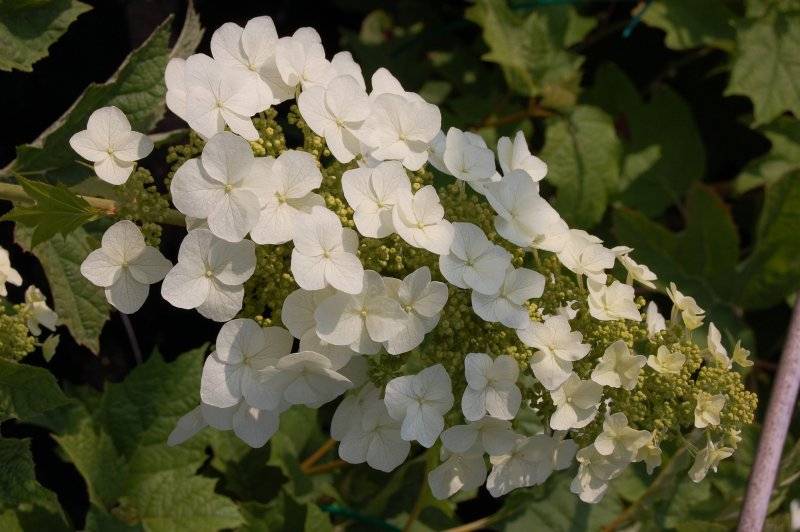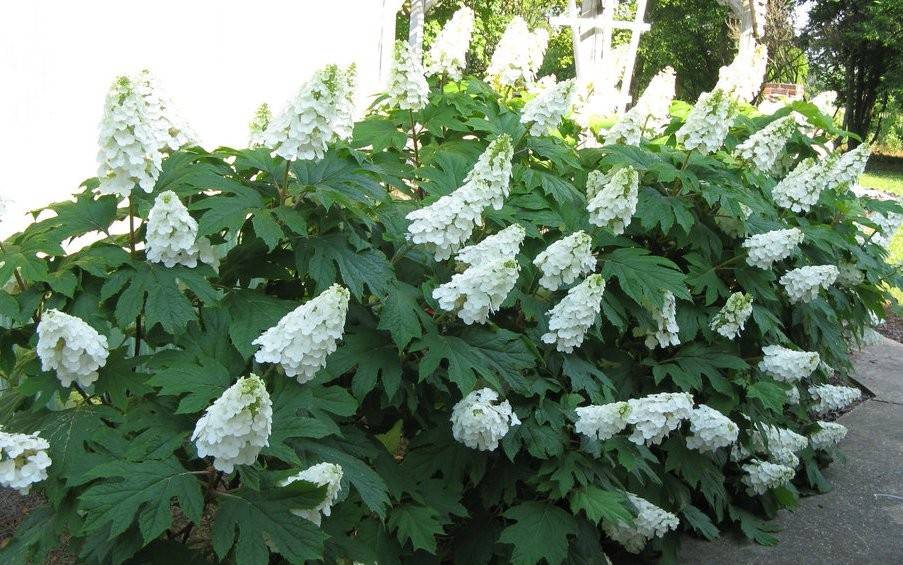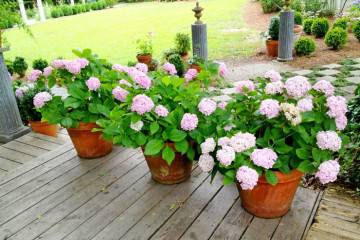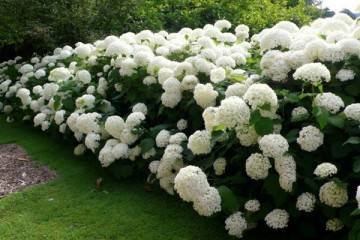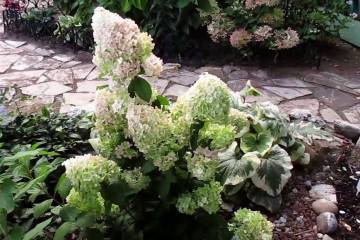Hydrangea oakleaf - winter-hardy varieties, planting and care
Content:
This ornamental shrub appeared in Russian gardens recently, but has already earned the love of many flower growers. Oak-leaved hydrangea will decorate any site; even a beginner can take care of it.
Origin and description of the appearance of oak-leaved hydrangea
North America is considered the birthplace of the oak-leaved hydrangea species. This species is unpretentious, it is a highly branched shrub, in most cases reaching 2 m in height.
The foliage is rough, like a quilt.
Benefits of culture:
- frost resistance;
- drought resistance;
- abundant flowering from June to frost;
- many varieties;
- resistant to diseases and pests.
Winter-hardy varieties of oak-leaved hydrangeas
The oak-leaved variety of hydrangea has many varieties, some of them are more popular, others have not yet taken root in the gardens of the Moscow region and the Moscow region. Nida described the most interesting, which showed the greatest winter hardiness.
A tall, two-meter shrub with dark velvet foliage and white paniculate inflorescences.
- Burgundy. The bush has rounded leaves, inflorescences of the color of red wine. It is not for nothing that this variety is also referred to as Burgundy. The bush is small, up to 1.5 m, growing slowly.
- Magic Amethyst. A distinctive feature is bright coral inflorescences. Hydrangea oak-leaved Amethyst grows up to two meters. In autumn, the leaves turn purple.
- Tennessee Clone. White simple flowers. The height of the bush is 1-2 m. The foliage is light green.
- Snowflake. White flowers with interesting layering. The petals are pointed, like snowflakes. Over time, they change color to light pink.
- Harmony. The variety has large inflorescences, similar to snow-white clouds. The bush is high, more than 1.5 m. The foliage is claret in autumn.
- Ice Crystal. The foliage of the variety almost does not turn red in the fall. White flowers are collected in lush inflorescences.
Transplanting oak-leaved hydrangeas after purchase into open ground
It is better to replant the bush in early spring or autumn.
Choosing the best place
The wedge-shaped hydrangea is planted in a sunny place or in partial shade.
Landing in a draft should be avoided. Special requirements are imposed on the soil. It should be fertile, moist, drained with an acidic reaction (pH 4.5-5).
What is needed for landing
To plant a hydrangea in a new place, you need:
- Dig a planting hole. It is dug in such a size that the roots of the seedling fit freely in it.
- The day before the transplant, water the hole with plenty of water.
- Pour soil for hydrangeas with a mound at the bottom of the pit.
- Add 20 g of superphosphate and potassium sulfate.
Step-by-step planting process
To properly transplant a hydrangea, you need to take the following steps:
- Transfer the seedling to the prepared hole.
- Spread out the roots carefully.
- Fill the hole with soil.
- Water abundantly.
- Mulch with peat, bark, sawdust.
Reproduction of oak-leaved hydrangeas
Nida describes the most common methods of vegetative propagation of hydrangeas.
Propagation by cuttings
Simple and affordable option.
Rooting cuttings are prepared in mid-July. Most suitable:
- cut from young plants or bushes after anti-aging pruning;
- from the lower side branches, a well-lit part of the bush;
- free of signs of diseases and pests;
- collected in the early morning.
Rooting order:
- After cutting, put the shoots in water immediately.
- Remove the top with a bud (if any) from the shoot.
- Divide the remaining shoot into segments with 2-3 pairs of leaves.
- From each cutting, cut the two lower pairs of leaves, and shorten the upper pair by a third.
- Place the cuttings in a rooting stimulant solution for 2 hours.
- Rooting is carried out in a moistened mixture of sand and peat (1: 2) under the jar.
- Water the cuttings 2-3 times a week.
- To withdraw the banks in a month.
The grown bushes are planted in a permanent place.
Growing from cuttings
Hydrangea is propagated by layering in early spring.
Breeding order in this way:
- Loosen and level the soil around the bush.
- Lay radial grooves up to 4 cm deep from the base of the bush.
- Take the lower shoot into each groove and pin it.
- By the beginning of autumn, 2-3 young plants are formed on each layer. When the babies reach a size of 15-20 cm, they are huddled to form lateral roots.
- In October, the babies need to be separated from the mother bush and dig in until spring.
Dividing the bush
The division of the hydrangea bush is combined with a transplant. The bush is carefully dug up and divided into several parts with a sharp secateurs, getting new small bushes. Delenki are rooted in the same way as seedlings. It is better to divide the bushes in the fall.
Oaky hydrangea care
Subject to the rules of agricultural technology, it is not difficult to grow a beautiful and healthy oak-leaved hydrangea.
Watering mode
A young bush is watered in the summer up to 2 times a week, adult bushes - 5 times a season. Pour up to 4 buckets of water at a time.
Top dressing
Hydrangeas are fed at least 2 times per season.
- in the spring before the buds appear. A solution of urea (10 teaspoons per bucket of water);
- in the fall after the end of flowering. Complex fertilizer is introduced.
There are many complex fertilizers for hydrangeas on the market. Using them will provide plants with all the necessary nutrients.
Pruning
The variety tolerates pruning in early spring well. In the period from March to April, all damaged branches are removed. During the growing season, faded inflorescences are cut off.
Features of care during the flowering period
During flowering, the plant needs regular, abundant watering. At the very beginning of the opening of the buds, you can feed the bushes with a solution of mullein or chicken droppings (1:10).
Features of care during the rest period
After the plant has bloomed, it is prepared for wintering:
- Dried inflorescences are removed.
- Huddle the base of the bush.
- Mulch the earth.
- Cover with spunbond on arches.
Preparing for winter
Even if the winter is predicted to be mild, it is better to play it safe and cover the bushes. This is usually done in October. The branches are tied, pressed to the ground, spunbond or lutrasil is used as a shelter.
Thus, oak-leaved hydrangea is a versatile shrub for the garden that requires a minimum of attention. The main thing is to properly plant and cover from frost at first.



